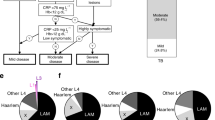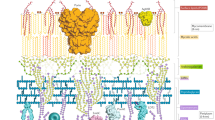Abstract
Tuberculosis remains the world's leading cause of death due to a single infectious agent, Mycobacterium tuberculosis, with 3 million deaths and 10 million new cases per year1. The infection initiates in the lungs and can then spread rapidly to other tissues2. The availability of the entire M. tuberculosis genome sequence3 and advances in gene disruption technologies4 have led to the identification of several mycobacterial determinants involved in virulence5,6,7,8. However, no virulence factor specifically involved in the extrapulmonary dissemination of M. tuberculosis has been identified to date. Here we show that the disruption of the M. tuberculosis or Mycobacterium bovis Bacille Calmette–Guérin (BCG) hbhA gene encoding the heparin-binding haemagglutinin adhesin (HBHA) markedly affects mycobacterial interactions with epithelial cells, but not with macrophage-like cells. When nasally administered to mice, the mutant strains were severely impaired in spleen colonization, but not in lung colonization. Coating wild-type mycobacteria with anti-HBHA antibodies also impaired dissemination after intranasal infection. These results provide evidence that adhesins such as HBHA are required for extrapulmonary dissemination, and that interactions with non-phagocytic cells have an important role in the pathogenesis of tuberculosis. They also suggest that antibody responses to HBHA may add to immune protection against tuberculosis.
This is a preview of subscription content, access via your institution
Access options
Subscribe to this journal
Receive 51 print issues and online access
$199.00 per year
only $3.90 per issue
Buy this article
- Purchase on Springer Link
- Instant access to full article PDF
Prices may be subject to local taxes which are calculated during checkout




Similar content being viewed by others
References
Dye, C., Scheele, S., Dolin, P., Pathania, V. & Raviglione, M. C. Consensus statement: global burden of tuberculosis: estimated incidence, prevalence, and mortality by country. WHO Global Surveillance and Monitoring Project. J. Am. Med. Assoc. 282, 677–686 (1999).
Balasubramanian, V., Wiegeshaus, E. H., Taylor, B. T. & Smith, D. W. Pathogenesis of tuberculosis: pathway to apical localization. Tuber. Lung Dis. 75, 168–178 (1994).
Cole, S. T. et al. Deciphering the biology of Mycobacterium tuberculosis from the complete genome sequence. Nature 393, 537–544 (1998).
Pelicic, V. et al. Efficient allelic exchange and transposon mutagenesis in Mycobacterium tuberculosis. Proc. Natl Acad. Sci. USA 94, 10955–10960 (1998).
Berthet, F.-X. et al. Attenuation of virulence by disruption of the Mycobacterium tuberculosis erp gene. Science 282, 759–762 (1998).
McKinney, J. D. et al. Persistence of Mycobacterium tuberculosis in macrophages and mice requires the glycoxylate shunt enzyme isocitrate lyase. Nature 406, 735–738 (2000).
Camacho, L. R. et al. Identification of a virulence gene cluster of Mycobacterium tuberculosis by signature-tagged transposon mutagenesis. Mol. Microbiol. 34, 257–267 (1999).
Cox, J. S., Chen, B., McNeil, M. & Jacobs, W. R. Jr Complex lipid determines tissue-specific replication of Mycobacterium tuberculosis in mice. Nature 402, 79–83 (1999).
Henderson, H. J., Dannenberg, A. M. Jr & Lurie, M. B. Phagocytosis of tubercle bacilli by rabbit pulmonary alveolar macrophages and its relation to native resistance to tuberculosis. J. Immunol. 90, 553–556 (1963).
Teitelbaum, R. et al. The M cells as a portal of entry to the lung for the bacterial pathogen Mycobacterium tuberculosis. Immunity 10, 641–650 (1999).
Menozzi, F. D. et al. Identification of a heparin-binding hemagglutinin present in mycobacteria. J. Exp. Med. 184, 993–1001 (1996).
Reddy, V. M. & Kumar, B. Interaction of Mycobacterium avium complex with human respiratory epithelial cells. J. Infect. Dis. 181, 1189–1193 (2000).
Pethe, K. et al. Mycobacterium smegmatis laminin-binding glycoprotein shares epitopes with Mycobacterium tuberculosis heparin-binding haemagglutinin. Mol. Microbiol. 39, 89–99 (2001).
Pethe, K. et al. Characterization of the heparin-binding site of the mycobacterial heparin-binding hemagglutinin adhesin. J. Biol. Chem. 275, 14273–14280 (2000).
Delogu, G. & Brennan, M. J. Functional domains in the mycobacterial hemagglutinin, HBHA. J. Bacteriol. 181, 7464–7469 (1999).
Menozzi, F. D. et al. Molecular characterization of the mycobacterial heparin-binding hemagglutinin, a mycobacterial adhesin. Proc. Natl Acad. Sci. USA 95, 12625–12630 (1998).
Pavelka, M. S. & Jacobs, W. R. Jr Biosynthesis of diaminopimelate, the precursor of lysine and a component of peptidoglycan, is an essential function of Mycobacterium tuberculosis. J. Bacteriol. 178, 6496–6507 (1996).
Teitelbaum, R. et al. A mAb recognizing a surface antigen of Mycobacterium tuberculosis enhances host survival. Proc. Natl Acad. Sci. USA 95, 15688–15693 (1998).
Quandt, J. & Hynes, M. F. Versatile suicide vectors which allow direct selection for gene replacement in Gram-negative bacteria. Gene 127, 15–21 (1993).
Wei, J. et al. Identification of a Mycobacterium tuberculosis gene that enhances mycobacterial survival in macrophages. J. Bacteriol. 182, 377–384 (2000).
Acknowledgements
We thank W. R. Jacobs Jr for the gift of pYUB415; B. Gicquel for the gift of pPR27 and M. tuberculosis 103; J. P. Decavel for help in animal handling; and S. T. Cole, P. Bifani and A. R. Baulard for critically reading the manuscript. This work was supported by INSERM, Institut Pasteur de Lille, Région Nord-Pas de Calais, and the Ministère de la Recherche. K.P. and S.A. were supported by a fellowship from the Ministère de la Recherche and Aventis-Pasteur, respectively.
Author information
Authors and Affiliations
Corresponding author
Rights and permissions
About this article
Cite this article
Pethe, K., Alonso, S., Biet, F. et al. The heparin-binding haemagglutinin of M. tuberculosis is required for extrapulmonary dissemination. Nature 412, 190–194 (2001). https://doi.org/10.1038/35084083
Received:
Accepted:
Issue Date:
DOI: https://doi.org/10.1038/35084083
This article is cited by
-
Diminishing of Helicobacter pylori adhesion to Cavia porcellus gastric epithelial cells by BCG vaccine mycobacteria
Scientific Reports (2023)
-
In Silico Analysis of a Candidate Multi-epitope Peptide Vaccine Against Human Brucellosis
Molecular Biotechnology (2023)
-
Treatments of Mycobacterium tuberculosis and Toxoplasma gondii with Selenium Nanoparticles
BioNanoScience (2023)
-
Insights into the evolutionary history of the virulent factor HBHA of Mycobacterium tuberculosis
Archives of Microbiology (2021)
-
Identification of antigens presented by MHC for vaccines against tuberculosis
npj Vaccines (2020)
Comments
By submitting a comment you agree to abide by our Terms and Community Guidelines. If you find something abusive or that does not comply with our terms or guidelines please flag it as inappropriate.



